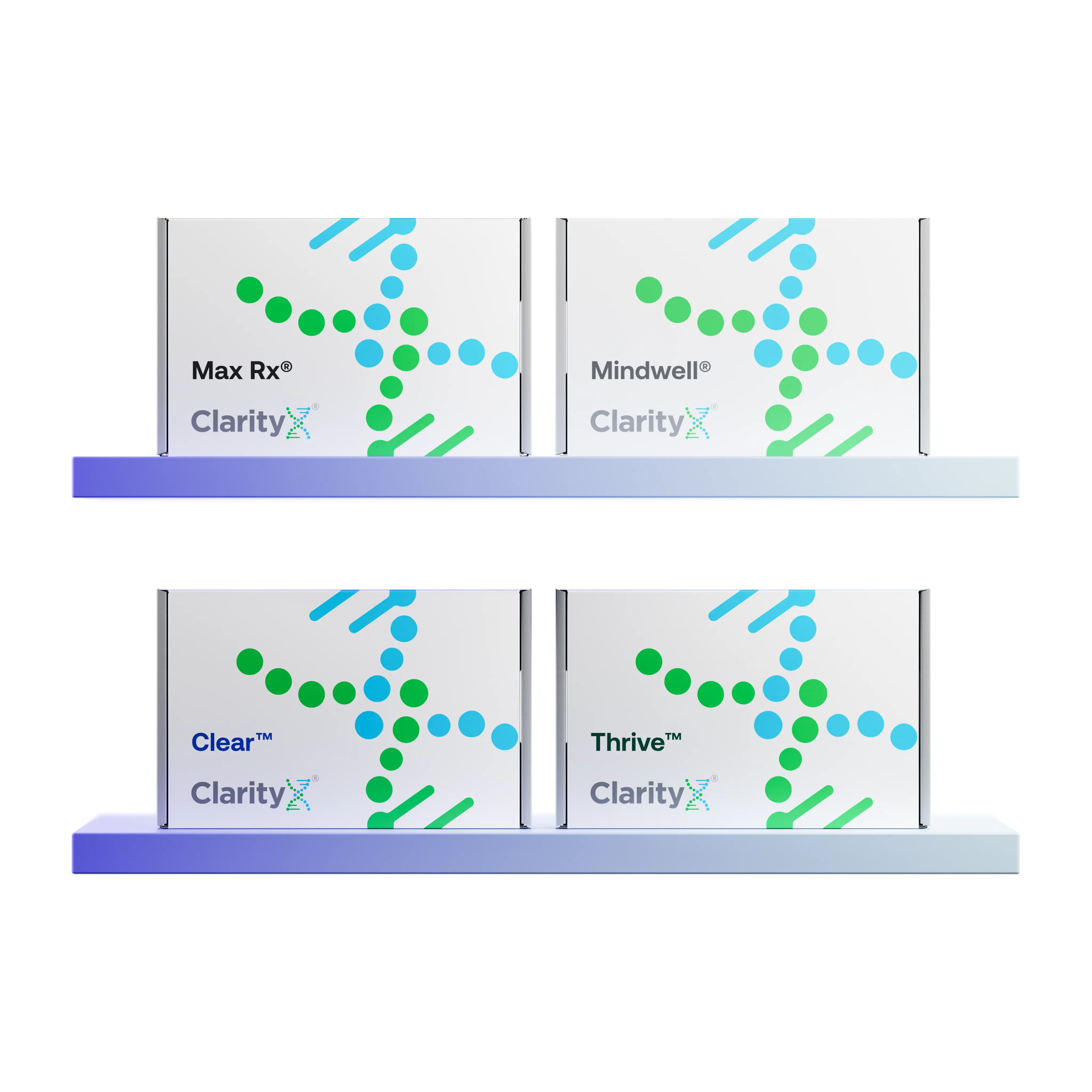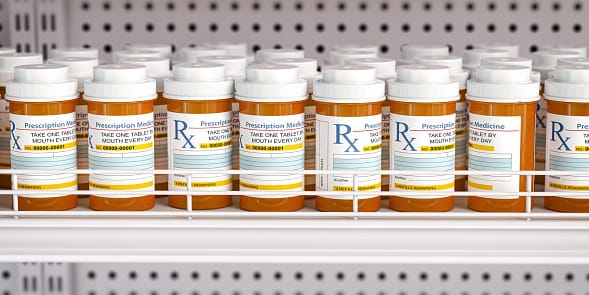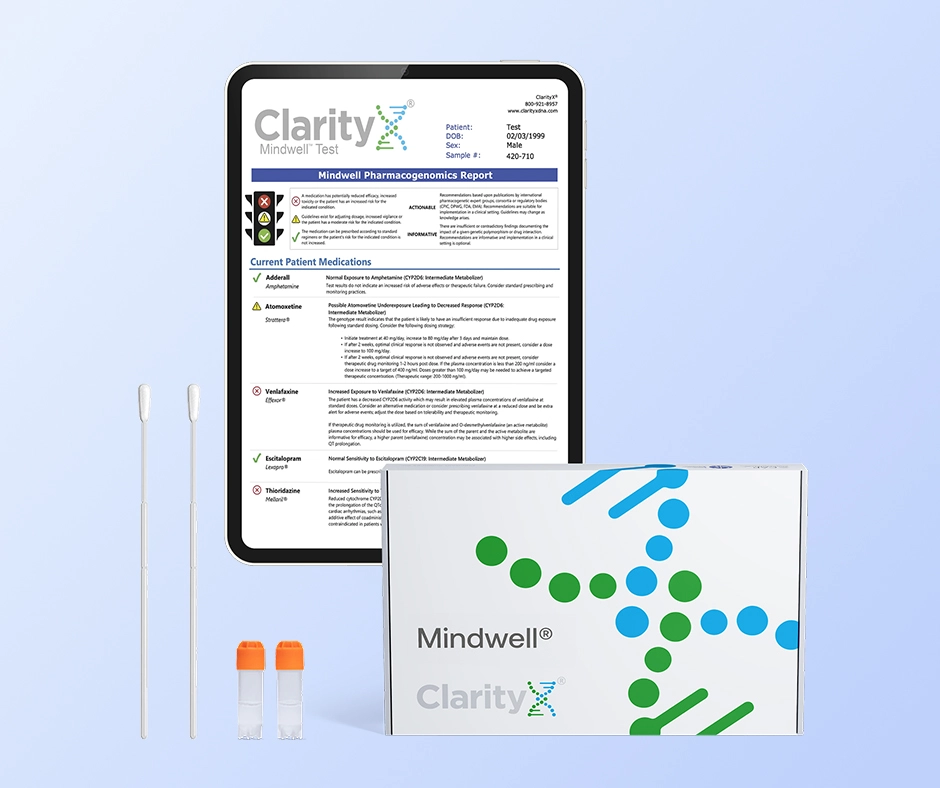According to a National Health and Nutrition Examination Survey conducted from 2015 to 2018 percentage of adults 18 years of age and older 13.2% of the population used antidepressants in the previous 30 days. It was also found within that survey that antidepressant use was higher in women (17.7%) versus the use in men (8.4%).1 In this guide, a closer look at two common antidepressants, fluoxetine (brand name Prozac) and fluvoxamine (brand name Luvox), will be reviewed. In addition, information about ClarityX’s unique pharmacogenomic (PGx) test called Mindwell can be used to help determine which of these two medications would be best to use.
Introduction
Fluoxetine (Prozac) and fluvoxamine (Luvox) are antidepressants that are in a class of medications called serotonin reuptake inhibitors (SSRI). To put it simply SSRI’s function is to help with mental health conditions by increasing the amount of serotonin in the brain by 60-80%. By increasing serotonin in the brain, it helps to significantly improve and elevate mood. SSRI’s are frequently used antidepressants due to their effectiveness, tolerability, and low likelihood of overdosing. SSRI’s are commonly used to treat mental health conditions like major depressive disorder, generalized anxiety disorder, obsessive-compulsive disorder, and post-traumatic stress disorder. Although they function similarly, these drugs are often used for different mental health diagnoses. Fluoxetine (Prozac) was originally approved in 1987 by the Food and Drug Administration (FDA) for the treatment of major depressive disorder. Fluvoxamine (Luvox) was originally approved for the treatment of obsessive-compulsive disorder in 1993 but is used off-label in some instances to treat major depressive disorders.2
Fluoxetine (Prozac) vs Fluvoxamine (Luvox) Formulations and Dosage
Fluoxetine (Prozac) is available in many formulations such as capsules, tablets, and liquid. Initially dosing for adults begins with taking 20mg in the morning. If patients are more sensitive to medications or their genetics affect how they react to medications the dosage is usually started at 10mg in the morning. It is common to see doses increased by 10mg increments with doses as high as 80mg being used to treat mental health conditions.3
Fluvoxamine (Luvox) is also available in other formulations such as tablets and capsules where they are either immediately released in the body or slowly released throughout the day. Starting doses typically begin at 25mg to be given at bedtime as it can cause drowsiness. It is important for patients who are more sensitive to medications or if their genetics affect how they may respond to medications to begin at lower doses to avoid unwanted side effects. Standard doses range between 50 to 200mg daily. Dose increases are generally recommended to start with 25mg increments over the course of two weeks. When reaching doses of 100mg or higher it is recommended to separate doses into two divided doses. Doses of 300mg daily have been used in the treatment of mental health conditions.4
Fluoxetine (Prozac) vs Fluvoxamine (Luvox) Side effects
Fluoxetine (Prozac) has many benefits when treating mental health conditions. However, there are some side effects to consider when selecting the right therapies for you. For example, some of the most common unwanted side effects that are experienced by greater than 10% of individuals while taking fluoxetine are as follows: decreased libido, sexual dysfunction, loss of appetite, upset stomach, and diarrhea.5
| Side effects of fluoxetine | Side effects of fluvoxamine | Side effects of both drugs |
| Headaches | Sweating | Changes in appetite |
| Weight fluctuation | Skin rashes | Sexual side effects |
| Heart palpitations | Muscle pain | Trouble sleeping |
| Constipation/stomach issues | Diarrhea and gas | Dizziness and nausea |
| Stuffy nose | Frequent yawning | Sore throat |
Fluvoxamine (Luvox) has been shown to improve overall symptoms of various mental health conditions. However, in greater than 10% of individuals that begin treatment with fluvoxamine, it has been observed that patients will experience the following: drowsiness, dizziness, nervousness, loss of appetite, ejaculatory disorder, and muscle weakness.6
Fluoxetine (Prozac) vs Fluvoxamine (Luvox) Drug Metabolism
Of course, every patient has their own experience with medications. Some may undergo extensive side effects, while others respond with the desired outcomes. Many times, effects are directly connected to how enzymes (CYP450 enzymes) in the body responsible for metabolizing (eliminating or activating) drugs are impacted by an individual’s genetics.
Fluoxetine (Prozac) is primarily metabolized by the CYP2D6 enzyme. Fluoxetine requires CYP2D6 to metabolize its active form in the body S-fluoxetine. An individual’s genetics can affect how this enzyme functions in the body. For a person who is labeled as a poor metabolizer of CYP2D6, it can affect the effectiveness of fluoxetine lowering the likelihood that it will be an effective treatment for a patient. In this case, it may warrant either discontinuing therapy with fluoxetine or not even beginning treatment.7
Fluvoxamine (Luvox) is also primarily metabolized by CYP2D6 with some metabolism from CYP2C19. Fluvoxamine relies on CYP2D6 to be eliminated from the body. Therefore, if an individual is found to have poor metabolism function with the CYP2D6 enzyme a person could experience elevated levels of fluvoxamine in the body. This can result in unwanted side effects or adverse events. In this case, it's recommended to consider reducing the initial starting dose of fluvoxamine by 25-50% or to use an alternative drug not metabolized by CYP2D6.8
ClarityX Pharmacogenomic (PGx) Testing
Trying to decide between two different medications can be overwhelming. ClarityX can help people make well-informed choices about their medications through pharmacogenetic (PGx) testing. Put simply, pharmacogenomic (PGx) testing evaluates your genes for variations that may affect how you metabolize certain drugs. With this information, you’ll know whether you need to adjust your dosage or avoid a drug entirely. The Mindwell test can help provide information on treatments designed for mental health conditions, including antidepressants, antipsychotics, and anxiolytics.
The Mindwell test from ClarityX provides a seamless in-home testing experience. Simply visit the website clarityxdna.com, select the Mindwell test option from the drop-down menu, and complete the checkout process. Once the kit is received follow the package instructions, perform a simple cheek swab, then mail the sample back using the prepaid envelope. The sample is then sent to the lab for processing and the results are received by the patient or provider in 7-14 days on average.
One of the most important facts about pharmacogenetic (PGx) testing is the results can be reevaluated for future medication changes as this test does not have to be repeated for those specific genes tested. Another key function of the Mindwell test is specific medications can be entered to be evaluated to see how an individual’s genetic makeup can affect those therapies. Pharmacogenetic (PGx) testing can provide a lifetime of knowledgeable decisions about medication selection for healthcare teams.
When trial and error isn’t practical or simply too time-consuming and inconvenient, pharmacogenetic (PGx) testing for mental health medications can help providers prescribe proper dosages and determine which drugs will have the most benefit or potentially cause the most side effects. Having the proper mental health medication along with its appropriate dosage can have a huge impact on those with mental illnesses. It’s well documented that antidepressants can take up to four to six weeks before they provide any relief to mental health conditions like depression. More often than not patients will stop taking antidepressants usually within a few months because of negative side effects or the medication wasn’t working at all to resolve their symptoms. Patient’s abruptly stopping their mental health medications can produce other problems on top of their current mental health diagnosis such as withdrawal symptoms. Many of these complications can be avoided by simply having knowledge of how a patient uniquely reacts to mental health medications.
Citation
1Centers for Disease Control and Prevention. (2022, May 6). Nhanes – National Health and Nutrition Examination Survey homepage. Centers for Disease Control and Prevention. Retrieved May 16, 2022, from https://www.cdc.gov/nchs/nhanes/index.htm
2 Selective serotonin reuptake inhibitors: Pharmacology, administration, and side effects. UpToDate. (n.d.). Retrieved May 16, 2022, from https://www.uptodate.com/contents/selective-serotonin-reuptake-inhibitors-pharmacology-administration-and-side-effects#H399779781
3 Selective serotonin reuptake inhibitors: Pharmacology, administration, and side effects. UpToDate. (n.d.). Retrieved May 16, 2022, from https://www.uptodate.com/contents/selective-serotonin-reuptake-inhibitors-pharmacology-administration-and-side-effects#H399779781
4 Selective serotonin reuptake inhibitors: Pharmacology, administration, and side effects. UpToDate. (n.d.). Retrieved May 16, 2022, from https://www.uptodate.com/contents/selective-serotonin-reuptake-inhibitors-pharmacology-administration-and-side-effects#H399779781
5 Fluoxetine Drug Information. UpToDate. (n.d.). Retrieved May 16, 2022, from https://www.uptodate.com/contents/fluoxetine-drug-information?topicRef=14675&source=see_link#F54703991
6 Fluvoxamine Drug Information. UpToDate. (n.d.). Retrieved May 16, 2022, from https://www.uptodate.com/contents/fluvoxamine-drug-information?source=auto_suggest&selectedTitle=1~1—1~4—fluvoxa&search=fluvoxamine
7 Annotation of FDA Label for fluoxetine / olanzapine and CYP2D6. PharmGKB. (n.d.). Retrieved May 16, 2022, from https://www.pharmgkb.org/labelAnnotation/PA166104788
8 Annotation of CPIC Guideline for fluvoxamine and CYP2D6. PharmGKB. (n.d.). Retrieved May 16, 2022, from https://www.pharmgkb.org/chemical/PA449690/guidelineAnnotation/PA166127637






